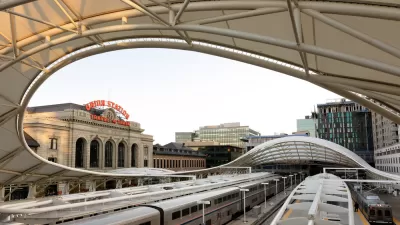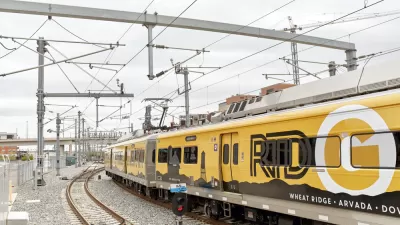Alex Schafran considers Denver's unique position as a trailblazer in suburban retrofitting and sustainable region-building, as an ambitious mass transit project grapples with a tradition of sprawl and fragmented politics.
Denver may not be the first city that springs to mind when it comes to avant-garde urbanism, what with its sprawling suburbs and historic craftsmans – but it is precisely for those traditionally American qualities that is now poised to reshape the way we think about the structure and hierarchy of metropolitan regions. As the Denver Metro area moves forward with FasTracks, a far-reaching expansion of its mass transit system, municipalities are launching corollary planning initiatives to prepare for the needs of a more regionally connected population.
While Downtown Denver pursues more transit-oriented development, it is suburban retrofitting that promises to set a standard for the regionally-conscious adaptation of suburbs elsewhere in the country.
"Denver is, in many ways, the prototypical 20th-century American city," Schafran writes — "a 'city of homes' (as the urban historian Carl Abbott deemed it), a fragmented and sprawling metropolis where the single-family home dominates land use... most of the region is a phenomenally extensive grid of interlocking municipalities, some of which — like Aurora — occupy space in three different counties."
These patterns of geographic development have produced a complex political backdrop for cooperation between local governments. "The history of incorporation and annexation is like a municipal game of Risk, with the rewards being tax base and territory. Aurora... just east of Denver, is now more than half the size of its more famous neighbor, and prefers to call the region the 'Aurora-Denver metro area.' Given the unprecedented cooperation between rival municipalities needed to complete the lengthy planning process, as well as the popular vote across eight counties to raise tax revenue in libertarian Colorado, we have to thing [sic] of FasTracks as a borderline miracle in American planning."
FULL STORY: Retrofitting a Rocky Mountain Metropolis

Trump Administration Could Effectively End Housing Voucher Program
Federal officials are eyeing major cuts to the Section 8 program that helps millions of low-income households pay rent.

Planetizen Federal Action Tracker
A weekly monitor of how Trump’s orders and actions are impacting planners and planning in America.

Ken Jennings Launches Transit Web Series
The Jeopardy champ wants you to ride public transit.

Washington Legislature Passes Rent Increase Cap
A bill that caps rent increases at 7 percent plus inflation is headed to the governor’s desk.

From Planning to Action: How LA County Is Rethinking Climate Resilience
Chief Sustainability Officer Rita Kampalath outlines the County’s shift from planning to implementation in its climate resilience efforts, emphasizing cross-departmental coordination, updated recovery strategies, and the need for flexible funding.

New Mexico Aging Department Commits to Helping Seniors Age ‘In Place’ and ‘Autonomously’ in New Draft Plan
As New Mexico’s population of seniors continues to grow, the state’s aging department is proposing expanded initiatives to help seniors maintain their autonomy while also supporting family caregivers.
Urban Design for Planners 1: Software Tools
This six-course series explores essential urban design concepts using open source software and equips planners with the tools they need to participate fully in the urban design process.
Planning for Universal Design
Learn the tools for implementing Universal Design in planning regulations.
Heyer Gruel & Associates PA
Ada County Highway District
Institute for Housing and Urban Development Studies (IHS)
City of Grandview
Harvard GSD Executive Education
Toledo-Lucas County Plan Commissions
Salt Lake City
NYU Wagner Graduate School of Public Service





























